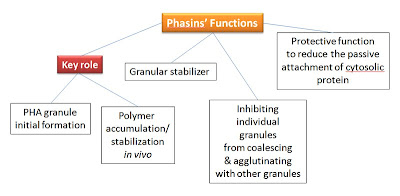Organization of PHA biosynthesis genes- Genes for PHA biosynthesisand other proteins that involved in metabolism of PHA usually clustered in bacterial genomes
- example:
in R.eutropha, genes for phaC, phaA and phaB contitute the phaCAB operon. a little downstram (4 kbp), a second B-ketothiolase gene was found. it can synthesize 3-ketoaceryl-CoA.
Primary structure of PHA synthase- Type I & Type II:
constitute of enzyme that is
* has 1 type of subunit (phaC)
* molecular weight: 61-68 kDa
- Type III:
* Preferentially utilise coenzyme A thioester (at least C5)
* enzyme that has 2 subunit:
a) PhaC (MW=40 kDa) : 21 - 28 % simlar to Type I & II
b) PhaE (MW=40 kDa): not similar with PHA synthases
* Both of the enzyme prefer coenzyme A thioester of 3HA SCL
- The mechanism that inveolved 2 thiol groups of PHA synthases during catalytic cycle was proposed by Giebel et. al.
* But, in the multiple alighnment of PHA synthases, only cysteine residue (cys-319) is able to be conserved
* So, scientist are trying to find another 1 thiol group.
- cys-319: determintaion of its role in reaction mechanism was obtained from site-specific mutagenesis
- cis-459:
* supposely involved in catalytic cycle that could make the second thiol grioup to be discovered.
* but, the site-specific mutagenesis shows that this amino acid residue is not essential for catalytic activity
* proven when we look at the alignment of PHA synthase sequence.
Secondary and Quarternary Structures of PHA Synthases- secondary structure (prediction)
* based on multiple alignment of PHA synthases (accuracy 72 %)
* mainly composed of variable loop (49.7 %), a-helical (39.9 %), B-sheet (10.4 %)
Factors determining the MW of PHAs- Type I: synthesize high MW (500 000 - millions)
- Type II: synthesize 50000 - 500 000
- Type III: synthesize MW between Type I and Type II



